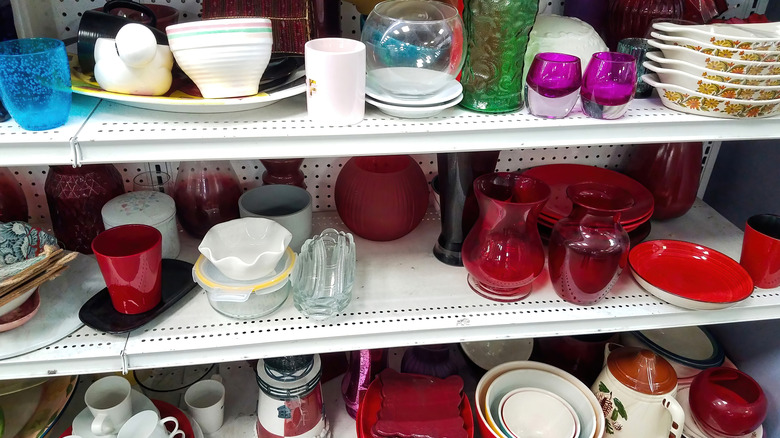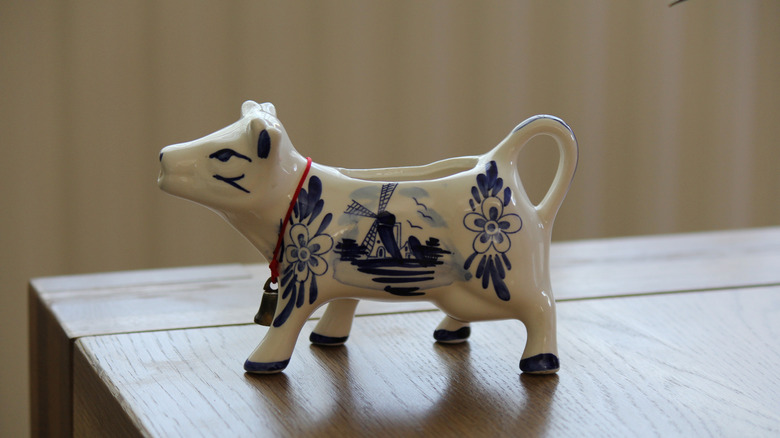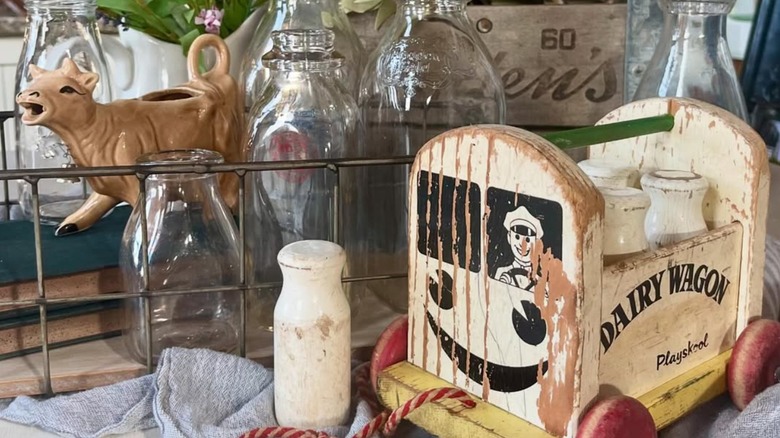The Vintage Kitchen Decor To Never Pass Up At The Thrift Store
Your local secondhand shop is an excellent stop to discover home decorations, especially retro ones. As you walk through the aisles, you'll notice a sea of kitchen items, including ceramics. These glazed pottery creations come in a variety of styles and uses; however, there's one piece that particularly stands out: cow creamers. Put simply, they're the kind of antique decor pieces that should be on your thrifting wishlist – and for good reason.
Creamers shaped like cows first appeared in Holland during the 18th century as a way to indicate the type of animal cream (or milk) that was in the canister. People would use it anytime they needed cream, whether that was for cooking, baking, or adding to tea and coffee. These pieces are typically made from ceramic, but you can also find older metal and plastic versions. Regardless, most feature an open hole on the back for the cream, with the tail doubling as a handle and the bovine's mouth serving as the pour spout. Antique renditions occasionally came with a lid, but many options are open-faced or no longer have their original covering.
These cattle creamers are available in multiple colors, styles, cow positions, and sizes. That said, because modern replicas exist, it's important to authenticate your find by checking the maker's mark, glaze thickness, and cowbell. Once you know you have a real piece, you can style it as farmhouse or quirky decor in your kitchen.
How to properly authenticate your cow creamer
The first place to check to make sure you have a vintage cow creamer is the bottom for a sticker or mark indicating the brand. Do note that super old creamers — especially those made from silver or types like Staffordshire, Pearlware, Prattware, and Creamware – may not have a marking. However, as technology advanced, manufacturers began marking their pieces.
Another way to know you have an older piece is to inspect its glaze thickness. While some early antique models have a thinner glaze, most versions have a thicker, shinier coating. But while the glaze may be denser, that doesn't mean they skipped out on the details. Older options are more precise, symmetrical, and ornate compared to the quick, manufactured versions made today.
Look closely at the cow's bell to gauge how old it is. What you're looking for is the material it was made of. Many original cow creamers had metal bells attached. Over the years, the metal may show wear and tear, like dents, scratches, and rust. You don't necessarily need to remove or repair the bell, but giving it a good polish (especially if there is rust on it) can help restore its appearance. For additional help on authenticating your latest thrifting find, you can always contact an appraiser or an expert.
Styling your cow creamer
Even though some cow creamers can fetch you a decent amount of money, they undeniably make charming decor pieces. Just strategically set it in a spot where it's easy to maintain yet still visible for everyone else to see. The style fits right in with farmhouse settings and pairs well with other cow-themed decor, bringing a rustic, farm character to your space. Then again, a retro cow creamer can also give a contemporary kitchen more personality. As an older piece, combine it with contemporary farmhouse items to add depth. While you may want to use the creamer, first make sure the interior is fully glazed, as unglazed or partially glazed surfaces can be hard to clean thoroughly. There's a chance you can get severely sick, so it's best to only use it as a decorative piece.
Sometimes in our homes, we have those funky or quirky items that just speak to us. A cow creamer can be that perfect addition. Don't be afraid to style lidless versions by filling them with flowers or other decorative kitchen elements. Or, if you prefer, display them as is. Luckily, there are plenty of ways to style a cow creamer as a focal item. Some people place theirs on shelves, window sills, or as a table centerpiece. No matter where you place it, don't forget to give it a good cleaning and dusting regularly.


